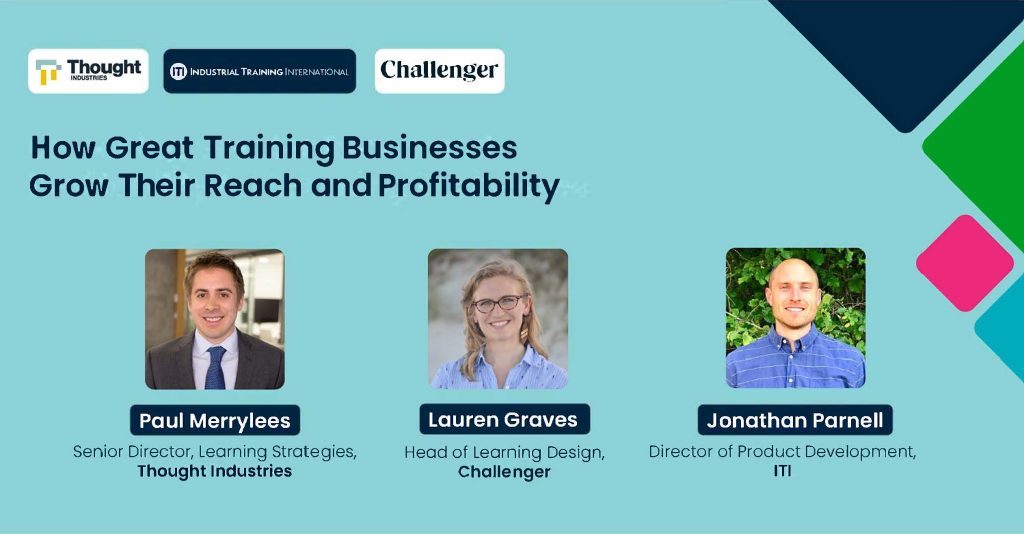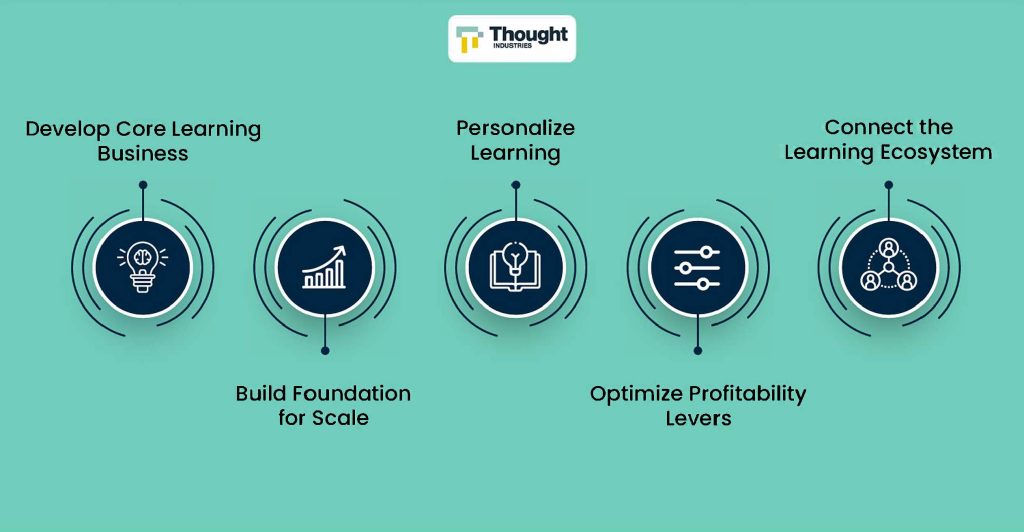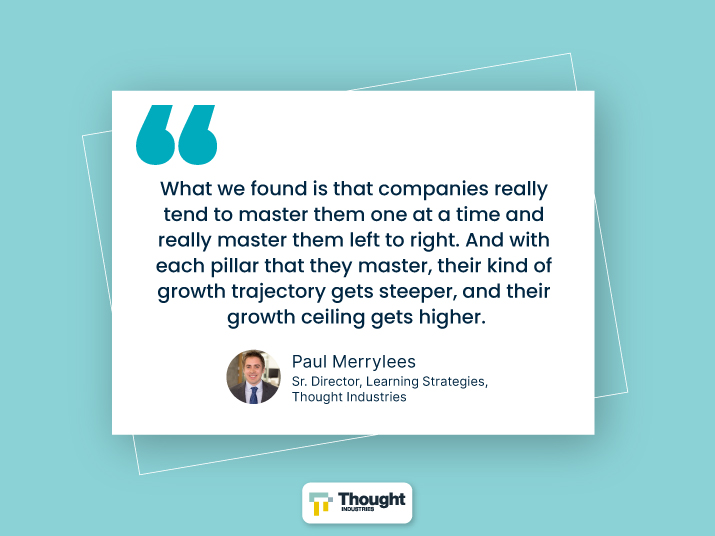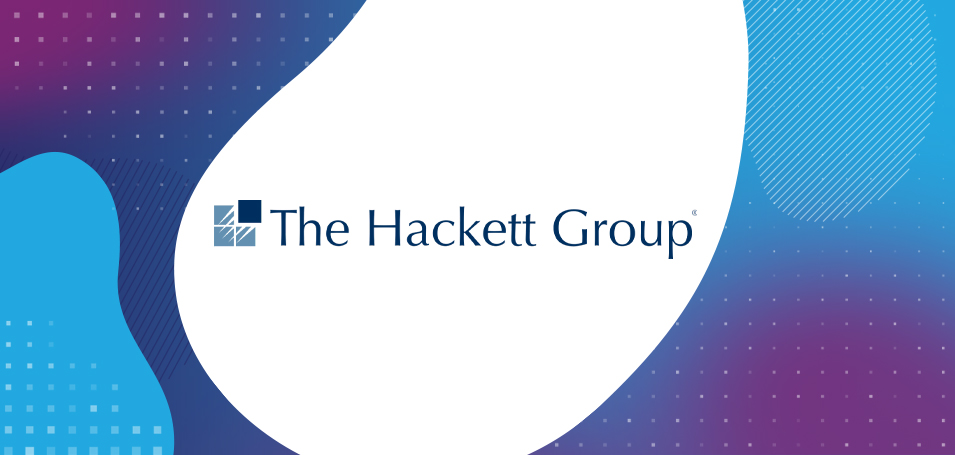In the world of learning businesses, challenges come with the territory. With constant organizational change, limited resources, and a laundry list of content to produce – growing a training business is no walk in the park.
The best way to approach growing your training business is to look to the experiences of others. For instance, take a closer look at the strategies of your most successful competitors. What are the most profitable learning businesses doing? What kind of problems have they faced, and how did they overcome them?

Paul Merrylees, Senior Director, Learning Strategies at Thought Industries, had a detailed discussion with Lauren Graves, Head of Learning Design at Challenger, and Jonathan Parnell, Director of Product Development at ITI, about the challenges companies have to overcome to grow their learning business.
The expert panel also highlighted how they experimented with the Maturity Model for Professional Training to unlock their growth potential. Read their insights below, or watch the webinar on-demand here.
5 Stages of Growing a Training Business and Maximizing Profit

What do all successful learning or training businesses have in common? What are their lingering pain points, and what best practices have they discovered in solving problems? Paul Merrylees observes that the journey to becoming a profitable learning business typically has five stages, outlined below.
Phase 1: Develop Core Learning Business
Phase one is an entrepreneurial challenge when you are constantly grappling with the following questions:
- What do you want to sell?
- Who do you want to sell it to?
- How can your learning product address the problems of your customers?
Sometimes you’re learning important lessons the hard way. But you keep refining your solutions until you get to the point where you’ve gone from starting with a blank canvas to a state of equilibrium.
Phase 2: Build Foundation for Scale
“The foundation really has two dimensions,” says Paul.
One is human capital capabilities, and you’ll need people with specific skills for instructional design, analytics, training, innovation, and product management. The other is technological capabilities that enable you to segment, personalize, ping, and prompt your users.
Phase 3: Personalize Learning
Phase three is segmenting your customer and learner base into the most meaningful groups. Start by identifying groups that need your expertise and your training the most. Use this segmentation data to differentiate your product and your offerings by segment.
Put simply, phase three is about moving from a one-size-fits-all approach to having it your way.
Phase 4: Optimize Profitability Levers
Phase four is when you go into the business’s control panel or executive suite. Then you start moving the levers and the dials of profitability. You keep making little changes in the strategy to serve your learners better and increase your profitability.
Phase 5: Connect the Learning Ecosystem
Finally, in phase five, organizations that manage to stay ahead of their competitors become connectors in their learning ecosystem. They manage to go from being peripheral players to the center.
They stop serving as one of many providers of learning offerings and services in a particular niche and start becoming the connector or the connective tissue in that in that area or in that domain.
To dive even deeper into the insights of our maturity model, check out our eBook, “5 Strategic Imperatives for High-Growth Learning Businesses.”

What Else Can Help Your Training Business Grow Profits and Improve Reach?
Apart from the five stages of professional training maturity, there are five building blocks or components you need to optimize to unlock your true growth potential. Let’s deep-dive into each of the components:
Choosing the Right Business Model
One of the most critical steps in starting a profitable professional training business is identifying opportunities to serve your clients.
The problem with many businesses comes down to structure—which can lead to wasted time and money. An excellent way to approach this problem would be to look at what other high-growth training businesses are doing and try to identify ways you can offer something different.
You may find gaps in the market for certain types of training that other companies have not yet addressed—this is a great place to start!
Mastering Product Distribution
There are several ways to get your training out there and make money. For example, you can create custom landing pages and use member management systems to deliver courses through the web.
You can also fully customize portals for clients that include courseware provided in other LMS platforms such as SCORM or xAPI.
Creating Content That Matters (and Sells)
If you have the expertise to create content, you can leverage that expertise to create more courses faster. You can also outsource content creation (or use a combination of both).
But this is where it’s important to stay on top of trends so that your courses and training programs are always up-to-date with industry standards.
Choosing the Right Platform
Poor tech won’t lead you anywhere today. Since there aren’t many LMSs available to training companies, many organizations choose to build their own LMS, which can often lead to inefficiencies and obstacles down the road.
A purpose-built LMS for enterprise learning is will offer tools and resources to power and grow your training business beyond your current goals.
Monetizing Effectively
Monetization is the final step toward achieving success in your professional training business. It’s also the one that can be most challenging to figure out, especially if you’re unsure how to price your courses or how much people are willing to pay for them.
You can maximize your assets by selling a la carte courses and subscriptions directly to the customer, expanding your revenue stream by adding consultation to courses, and using licensing to leverage expertise.
ITI’s Steps Toward Digital Transformation
Referring to the stages of the Maturity Model, Jonathan from Industrial Training International (ITI) says he sees his company on stage three kind of personalized learning, but in some parts, ITI is still back at stage 2: building foundations for scale.
He explains that there are certain parts of the organization that are still considering how to best leverage a learning platform. Jonathan talked about the evolution of ITI and their recent expansion into virtual reality and eLearning.
“It wasn’t until about 2020 that we took control of our eLearning platform and partnered with Thought Industries to create the Learning Hub,” adds Jonathan.
About their partnership with Thought Industries, Jonathan reveals that they now benefit from a suite of helpful resources, including tools for course creation, certificate management, and Learning Path management. In the past few years, ITI has implemented some significant changes to their content. Jonathan explains:
“We started to understand that you can’t hold someone hostage in an e-Learning environment for hours on end. So, we took our content duration down from 30 minutes to about eight minutes on average. And I think that improved learner acceptance of the platform and method.”
When asked about adopting VR simulation as a component of the training program and hub, Jonathan briefly talked about the data-first approach for their crane simulator and how they are planning to use LMS as an aggregator of information. This ensures that learner records can be processed accurately.
The eLearning Wave at Challenger
Lauren considers her learning business to be somewhere between stage two to four of the Maturity Model. Challenger was originally a part of CEB, which is a member-based research organization. They switched from in-person to an eLearning model around 2013.
One of the biggest perks of partnering with Thought Industries, she says, has been the additional flexibility for Challenger to grow their online training business and build virtual-led workshops.
She also mentioned that the SCORM Connect capability has been a real game-changer for them. “It’s absolutely critical in our space that we meet our learners where they are.”
Watch the Webinar On-Demand
“This is not a science; this is more of an art,” Paul concludes. The more stages you unlock, the steeper your growth trajectory becomes.
For more insights on the Maturity Model for Professional Training, watch the webinar on-demand here.



